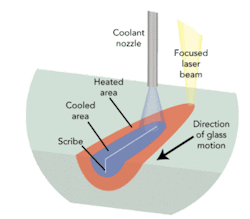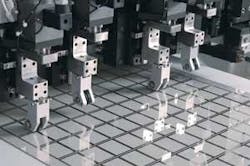Frank Gaebler, Coherent Inc.
Recent advances in CO2 laser reliability, process cooling techniques, and glass handling have enabled lasers to offer a viable alternative to mechanical methods
Virtually all types of flat panel displays (FPDs) currently in production utilize thin sheet glass in their construction. However, the traditional mechanical technique for glass cutting does not possess the characteristics necessary to support the quality and throughput required by many emerging display applications, particularly those utilizing very thin substrates. While CO2 lasers have been used in specialized glass cutting applications for many years, recent advances in CO2 laser reliability, process cooling techniques, and glass handling have enabled lasers to offer a viable alternative to mechanical methods for a broader range of FPD manufacturing applications than ever before. This article reviews the basic techniques and requirements of laser glass cutting and compares them with traditional methods (see Figure 1).
Thin is in
For consumer electronics products like PDAs and MP3 players, there is a relentless drive toward smaller physical size and lighter weight, as well as reduced cost. Paradoxically, there is also a concurrent consumer demand for larger, higher quality displays in these devices, with the Apple iPhone being a premier example. Similarly, flat screen television manufacturers are looking to reduce the weight of their products. The answer in both cases is to use a thinner glass substrate. In ultra-thin phones the thickness is being reduced to 0.3mm. Even in large (60-in.) televisions, a thickness of 2.8mm is now standard.
Thinner glass, however, is more mechanically delicate. This makes it more difficult to cut and handle the glass in production, and also results in a final product that can be more easily broken. The latter factor is especially important in screens that double as touchpads.
The laser edge
The traditional technique for cutting glass, in use in various forms literally for centuries, involves scribing the surface of the glass with a hard, sharp tool (typically a diamond or carbide wheel), followed by a mechanical snapping force to propagate the crack completely through the glass. In automated systems, this separation is usually implemented by using a “chopper bar,” which descends on the glass.
Unfortunately, this method has certain drawbacks for very thin substrates. In particular, the mechanical force of the cutting tool produces microcracks in the material, and the subsequent breaking step yields small chips and debris, plus an edge that is not necessarily perpendicular to the glass surface. Furthermore, mechanical cutting leaves significant mechanical stress in the finished edge. (In fact, it becomes difficult to use mechanical cutting at all with substrates below about 1mm in thickness because the glass is so easily broken.) To prevent further cracking or breaking of the glass after the original cut, it may therefore be necessary to grind or polish the cut surface. Also, a post-process cleaning step may be required to remove debris that could interfere with subsequent processes, such as circuit formation.
Laser glass cutting addresses several of these limitations. First, it is a non-contact process that completely eliminates the problem of microcracking and chipping. Also, laser cutting produces essentially no residual stress in the glass, resulting in higher edge strength. This is critical because even when force is applied to the center of a glass panel, any break usually initiates at the edge. Consequently, laser cut glass can withstand two to three times as much force as mechanically cut glass.
Laser cutting can also reduce the number of process steps because it doesn’t require any subsequent cleaning or grinding stages. So while the capital cost for a laser cutting station is higher than for a mechanical system, the overall investment in laser cutting can be lower than for mechanical processing if an additional grinding machine can be eliminated.
Finally, laser cutting makes it easier to produce curved cuts in glass. The demand for curved cuts is increasing, especially in mobile phones, where many manufacturers would like to replace plastic covers with glass to increase scratch resistance. However, this generally requires small radius rounded edges, and sometimes even cut-outs.
Laser cutting basics
There are two basic laser based techniques for glass cutting. The first is called laser scribing, which is primarily used for substrates in the 0.3–0.7mm thickness range (see Figure 2). The second is referred to as laser full body cutting, and is utilized mostly with very thin substrates of 0.2mm or less. Both methods typically use a continuous wave (CW) CO2 laser, or a pulsed CO2 laser whose repetition rate is high enough to appear essentially CW at the feed rates used in this application.
In laser scribing, the laser is focused on the surface of the glass, which is being translated to create a continuous cut. Because all glasses strongly absorb the 10.6μm CO2 laser wavelength, essentially all the laser energy is deposited at or near the surface of the glass, causing rapid heating. Either liquid or air is then delivered by nozzles onto the glass to quickly cool it; the resulting thermal shock produces a continuous crack in the glass that is typically about 100μm deep. After the entire scribing is completed, the glass then passes under a mechanical roller or controlled chopper bar that imparts enough force to propagate the crack through the entire substrate and break it. This break is free of debris and perpendicular to the surface.
An alternative, non-mechanical method for breaking the glass recently has been introduced. Here, the original scribe is again exposed to heat, usually from a second laser, to expand the glass and drive the crack all the way through the substrate. No cooling is used in this phase.
The setup for laser full body cutting is similar to laser scribing. The difference is that the feed rate is lowered, and the level of cooling is reduced with gas being used instead of liquid. As a result, the laser induced crack continues all the way through the thin substrate in a single step, thus eliminating the need for a separate breaking process. The table summarizes the characteristics of mechanical cutting and the two laser techniques.
Process optimization
MDI Schott Advanced Processing GmbH (Mainz, Germany) is a manufacturer of high precision glass cutting equipment that has developed laser based technologies for a variety of applications. MDI Schott has focused on FPDs in particular.
“We’ve optimized several aspects of the process in order to deliver a tool to manufacturers that is cost-competitive with mechanical cutting, and which produces superior results for thin substrates,” notes Christoph Hermanns, executive VP. “In particular, delivery of the coolant was an area of significant focus. We studied the effects of various gases and liquids, and developed new technology for spray nozzles that deliver the coolant in a way that yields highly controllable and repeatable results. Additionally, these minimize liquid coolant volume and can utilize fluids that leave no residue on processed parts.”
The company also found that the normal Gaussian beam profile is not optimum for glass scribing. The problem is that a focused Gaussian distribution has a strong intensity peak at the center of the scribe, which can heat the glass past its transformation temperature, where it actually liquifies. This local transformation produces residual stress, which can subsequently cause microcracks.
MDI Schott Advanced Processing utilizes several techniques for altering the delivered laser power distribution depending upon the specific glass being cut and other process parameters. One way is to use a lens system or reflective optics to produce a line-shaped beam. Also, the beam can be scanned back and forth at high frequency along the scribe line (Figure 3).
Typically, the company uses CO2 lasers in the 50–250W power level; the higher end of the range enables either increased throughput or the ability to work with thicker substrates.
“One of the lasers we’re using is the Coherent Diamond K250, which possesses several characteristics that are critical in our application,” states Hermanns. “For example, we require very good power stability since scribe depth depends directly upon power. For the same reason, consistency in transverse mode structure is important since this determines the laser power distribution on the work piece. Furthermore, we need the output distribution to remain constant over the entire output power range of the laser. That’s because a given machine might be used for several different tasks, such as scribing both bare glass and coated glass, which would require different power levels. Also, unit-to-unit mode consistency is important so that when we install a new laser we don’t have to recalibrate everything.”
Hermanns also emphasizes the importance of uptime and reliability, because this is an application that typically runs in a 24/7 mode. “Coherent recently introduced the Diamond E-400 laser, and we’re utilizing it because of its excellent reliability characteristics,” he reports. “For example, this laser has an integrated power supply, which eliminates the RF power cable, which is a potential source for failure. Also, the E-400 has built-in self-diagnostics that monitor virtually all laser operating parameters and can predict possible failures in advance. And the laser itself is a web server so we can even monitor units at a remote site and inform our customers of any impending problems.”
Conclusion
In conclusion, the demands of 21st century consumer products mean that the glass panels used in their displays can no longer be cut using centuries-old techniques. Fortunately, laser based “cutting” avoids the critical limitations of these methods. Because laser cutting can eliminate post-processing steps, it can be utilized without unduly increasing product costs.
Frank Gaebler ([email protected]) is senior product marketing manager at Coherent Inc. in Bloomfield, CT; ph 860/769-3130; www.coherent.com.




